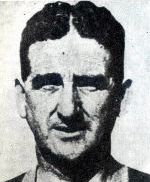William Garbutt
 | |||
| Personal information | |||
|---|---|---|---|
| Full name | William Thomas Garbutt | ||
| Date of birth | 9 January 1883 | ||
| Place of birth | Hazel Grove, England | ||
| Date of death | 24 February 1964 (aged 81) | ||
| Place of death | Warwick, England | ||
| Position(s) |
Outside right | ||
| Senior career* | |||
| Years | Team | Apps | (Gls) |
| 1903–1906 | Reading | ||
| 1906–1908 | Woolwich Arsenal | 52 | (8) |
| 1908–1911 | Blackburn Rovers | 82 | (10) |
| 1911–1912 | Woolwich Arsenal | 0 | (0) |
| Managerial career | |||
| 1912–1927 |
Genoa | ||
| 1913–1914 | Italy[1] | ||
| 1927–1929 |
Roma | ||
| 1929–1935 |
Napoli | ||
| 1935–1937 | Athletic Bilbao | ||
| 1937 |
Milan | ||
| 1937–1940 | Genoa | ||
| 1946–1948 | Genoa | ||
| *Club domestic league appearances and goals | |||
William Thomas Garbutt (9 January 1883 – 24 February 1964[2]) was an English professional football coach and player. His contribution to Italian football through laying the foundations of player training and coaching popularized the sport in the nation, and he was widely considered the model for professional managers in Italy.
Born in the small village of
Garbutt would depart to join newly formed
Although his achievements are not widely known in his home country, Garbutt was instrumental in making Italian football popular, and is credited for laying the groundwork for the nation to secure victory during the 1934 and 1938 FIFA World Cups.
Biography
Garbutt
After returning from duties, he began his club football playing career with Reading during the 1903 season and played for them in the Southern League, before leaving in December 1905.[4]
The young winger moved to join Woolwich Arsenal for two seasons, and made his debut in a First Division match away to Preston North End on 23 December 1905, which finished 2–2. He made 80 appearances for the London club in three years, including 52 in the League, despite injuries ruling him out of much of the 1906–07 season. He was part of the Arsenal side that reached two FA Cup semi-finals in successive seasons; however he was eventually displaced by Jackie Mordue and after spending much of 1907–08 in the reserves he left for Blackburn Rovers in May 1908.[5][6]
He spent four seasons playing for Blackburn, making 82 league appearances His playing career having been blighted by injuries, he retired from playing in 1912, aged 29.
Genoa: Impact on Italian football
He moved to
He was appointed as the new head coach of Genoa CFC on 30 July 1912, with no previous experience and only aged 29. It is not clear how he came to be their manager, some reports say he was recommended by Vittorio Pozzo;[8] who would go on to coach Italy to two World Cups. Indeed Pozzo became acquainted with him,during a stint in England, but he had no particular relationship with Genoa C.F.C. and he was surprised when he met Garbutt again in Italy. Others state it was Genoa's youth coach, an Irishman named Thomas Coggins, who pushed for Garbutt's appointment.
Garbutt restructured the training regimes, putting a heavy emphasis on players physical fitness and tactics. This was not the only part of managing in Italy that Garbutt set the proto-type for; he conducted Italy's first ever paid player transfers, where he signed two players from
From when Garbutt first took over in 1912, until 1927 when he left the club, Genoa were victorious in the
Post-Genoa adventures
On 22 July 1927 a new club was founded from the merger of numerous clubs in Italy's capital of Rome, the new club in question was
Garbutt moved on next to Naples, taking over from Giovanni Terrile at
In search of a new adventure, Garbutt moved to Spain in 1935. He took up the position as manager of
Later years
William Garbutt soon moved back to the club where he was held in such high regard; Genoa. Since Garbutt had left in the 1920s, Genoa had gone into a slump even being relegated at one point. But with Garbutt back at the helm he coached the club back up to 3rd in his first season back.
His return would be short lived however, as a British citizen he was exiled under Benito Mussolini's fascists and returned home to England. After the end of World War II, Garbutt returned to Genoa for a third time and then returned home. By the time Garbutt died in 1964, he was an anonymous octogenarian living in reduced circumstances in Leamington Spa. Yet every newspaper in Italy carried a lavish obituary. He was deeply mourned, in Pozzo's words as 'the most important man in the history of Italian football'.[9]
Honours
Player
- Blackburn Rovers
- Lancashire Cup: 2: 1909, 1911
Coach
- Genoa
- Italian Football Championship: 1915, 1923, 1924
- Roma
- Coppa Coni: 1928
- Athletic Bilbao
- La Liga: 1935–36
References
- ^ Una ricostruzione storica conferma: l’inglese William Garbutt guidò per 6 gare gli Azzurri figc.it
- ^ a b "English Players in Italy". RSSSF.
- ^ Angrisani, Biagio, ed. (2004). Mister William Thomas Garbutt. Introduction by Antonio Ghirelli. La Campanella.
- ^ "The Reading FC Tour of Italy 1913". 1871 – the ultimate Reading FC website. Archived from the original on 30 June 2012.
- ^ ISBN 1-899429-03-4.
- ^ Billy Garbutt, Arsenal FC. Retrieved 10 January 2022
- ISBN 978-1-899468-67-6.
- ^ "Willy Garbutt, The Italian trailblazer". ClubFootball.
- ^ "Stockport's footie genius showed Italians the way". Stockport Express. 3 January 2007.
Further reading
Edgerton, Paul (2009). William Garbutt – Father of Italian Football. Cheltenham: SportsBooks.
